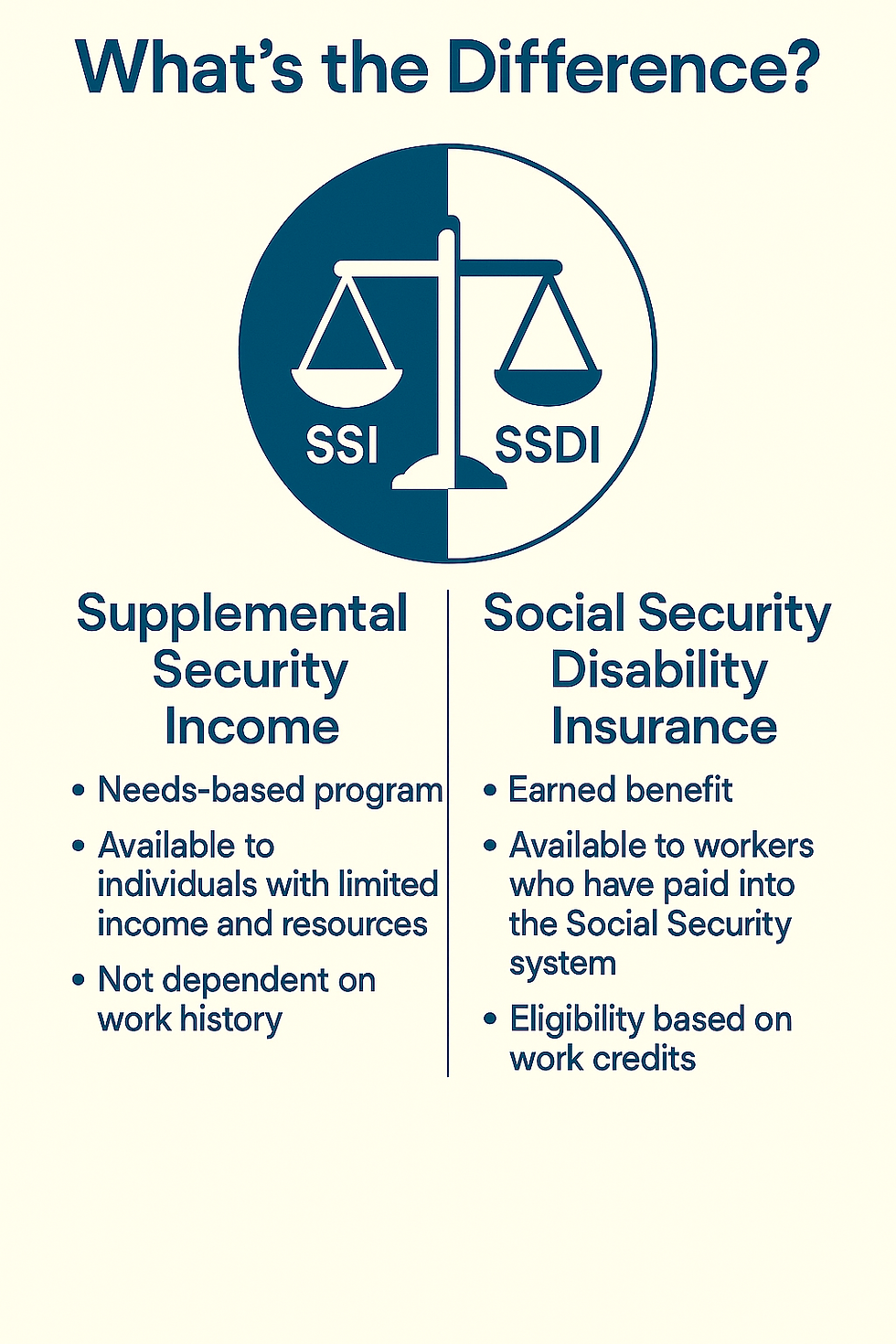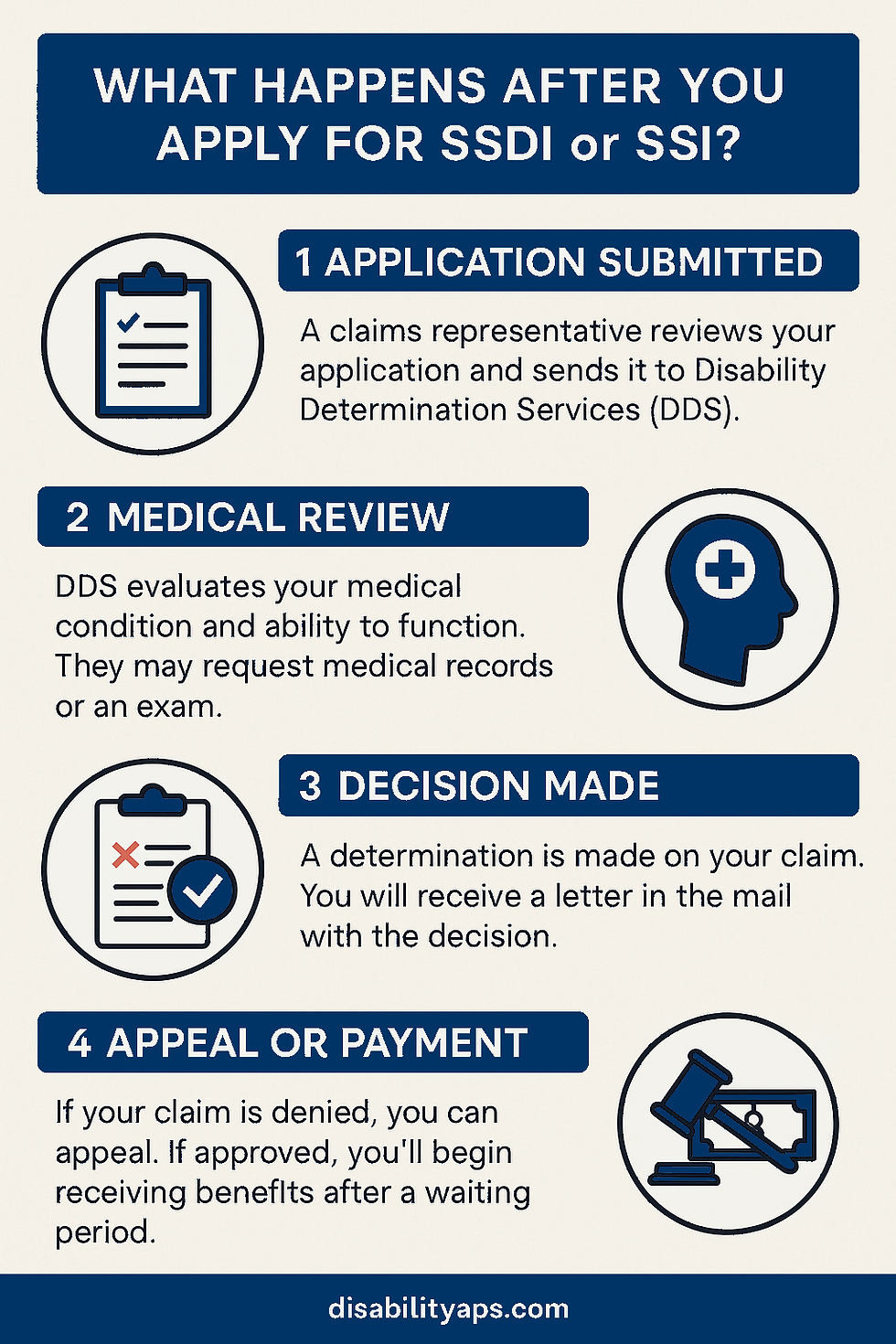SSDI vs. SSI: What's the Difference and Which One Applies to You?
- Advocate Pathway Solutions

- Aug 20
- 6 min read
Updated: Sep 12

Many people use SSDI (Social Security Disability Insurance) and SSI (Supplemental Security Income) interchangeably—but they’re very different programs with different rules, funding sources, eligibility tests, and benefit amounts. Understanding those differences up front can save months of frustration and help you apply for the right benefit the first time.
Below is a practical, plain-English guide—plus a quick decision path to help you figure out which program fits your situation (and when both might).
1. The core difference in one minute
SSDI is insurance you earn by working and paying FICA taxes. If you’ve worked long enough, paid into Social Security, and meet SSA’s disability definition, SSDI can pay you a monthly benefit based on your past earnings. After a waiting period, SSDI can also lead to Medicare coverage. Social Security+1Medicare
SSI is a need-based safety-net program for people who are aged (65+), blind, or disabled and have limited income and resources. It pays a federal base rate—in 2025 that’s $967/month for an individual and $1,450 for a couple—and some states add a small supplement. Most states grant Medicaid automatically when you receive SSI. Social Security
Feature | SSDI | SSI |
What it is | Disability insurance you earn through work | Need-based cash assistance |
How you qualify | Limited income/resources + aged 65+, blind, or disabled | |
How much it pays | Based on your earnings record (varies by person) | |
Health coverage | ||
Waiting period | No SSDI-style waiting period; begins once approved (financial rules apply) |
2. SSDI
2.1 Basic Rule
SSDI is for workers who paid into Social Security and can’t do substantial work because of a medical condition expected to last at least 12 months or result in death. You need enough work credits for your age and recent work (if you’re 31+, generally 20 credits in the 10 years before disability began).
2.2 What counts as "substantial" work (SGA)?
In 2025, the Substantial Gainful Activity (SGA) amount is $1,620/month for non-blind individuals and $2,700/month if you’re statutorily blind. Earning above SGA typically means SSA won’t consider you disabled (with special rules for blind SSI).
2.3 When benefits start?
If approved, SSDI has a 5-month waiting period; your first payment is due the sixth full month after your established onset date (ALS has special rules that waive the waiting period).
2.4 Health insurance tie-in
After 24 months of SSDI entitlement, you qualify for Medicare automatically (earlier for ALS; special rules for ESRD)
2.5 How much will SSDI pay?
Your monthly SSDI is based on your earnings history (it’s unique to you). SSA calculates it from your Average Indexed Monthly Earnings and Primary Insurance Amount. If your SSDI check is small, you may also qualify for SSI to “top up” your monthly income (see Concurrent benefits below).
3. SSI
3.1 Basic Rule
SSI pays a modest monthly benefit to people who are aged 65+, blind, or disabled and who have limited income and limited resources. The 2025 federal base rate is $967/month (individual) and $1,450/month (couple); some states add a supplement on top of the federal amount.
3.2 Resource Limits
Your countable resources must be $2,000 or less for an individual ($3,000 for a couple). Many essentials don’t count—like your primary home, household goods, and one vehicle used for transportation.
3.3 Income Rules
SSI looks at earned and unearned income, and in some cases deemed income from a spouse/parent. “In-kind” help with shelter can reduce your payment depending on your living arrangement—but as of September 30, 2024, food is no longer counted as in-kind support that reduces SSI. That update means if someone buys you groceries, it typically won’t lower your SSI anymore.
3.4 Health insurance tie-in
In most states, being awarded SSI also makes you Medicaid-eligible—often automatically when SSI is approved. A handful of states require a separate Medicaid application.
3.5 State supplements
Many states add a small SSI state supplement. Some are administered by SSA, others by the state. (For example, Florida administers its own supplement categories.) Check your state’s rules for details.
4. Quick Self-Check: "Which one applies to me?"
Have you worked and paid Social Security taxes recently and long enough for your age?
Are your current income and resources very limited?
Are you working above SSA's SGA thresholds?
Depend on your answers to the above questions you may be eligible for concurrent benefits. It’s wise to get a professional case evaluation before filing. You can start a free review with our team at disabilityaps.com/claim-evaluation.
5. When both may apply (concurrent benefits)
5.1 Concurrent Benefits
If your SSDI check is less than the SSI federal rate, you can often receive SSI as a “top-up” so your combined monthly income reaches the SSI level (plus any state supplement you’re eligible for). SSA calls this concurrent eligibility. Many people overlook this and leave money on the table.
Example: You qualify for SSDI but your check is $700/month. If you also meet SSI’s income/resource limits, SSI can add up to $267/month (in 2025), bringing you up to $967/month federally, possibly more with a state supplement.
6. Health Coverage: Medicare vs. Medicaid (and why it matters)
SSDI > Medicare: After 24 months of SSDI entitlement, you’re enrolled in Medicare automatically. This is federal health insurance that travels with you state-to-state. (ALS and ESRD have special earlier rules.).
SSI > Medicaid (most states): SSI often confers Medicaid coverage (automatic in most states; separate application in a few). Medicaid can be crucial for doctors, prescriptions, and long-term services that Medicare may not cover.
Some people on concurrent benefits end up dual-covered (Medicare + Medicaid), which can reduce out-of-pocket costs.
7. Key Numbers for 2025 (bookmark this)
SSI Federal Benefit Rate (FBR): $967/month (individual), $1,450/month (couple). Some states add a supplement. (Social Security)
SGA (Substantial Gainful Activity): $1,620/month (non-blind), $2,700/month (blind). (Social Security)
SSI resource limit: $2,000 (individual), $3,000 (couple). (Social Security)
SSDI waiting period: 5 full months (first payment in month 6). (Social Security)
Medicare after SSDI: Automatic after 24 months of SSDI entitlement (earlier for ALS; special rules for ESRD). (Social Security)
8. Mistakes That Sink Otherwise Good Claims
Gaps in treatment. SSA may assume your condition improved if you skip appointments.
Inconsistent statements. What you tell SSA, your doctor, and Vocational Rehabilitation should align.
Overstating or understating limitations. Credibility is key; SSA cross-checks.
Ignoring mental health. Depression and anxiety often co-exist with physical impairments—document both.
Filing appeals late. You get only 60 days to appeal a denial; miss it and you start over.
9. When (and Why) to Get Help
A seasoned non-attorney representative can:
Screen your claim for eligibility and completeness, saving you months of processing time.
Order and organize medical records in the format SSA prefers.
Draft persuasive legal briefs tying your evidence to SSA regulations.
Prepare you for hearings and cross-examine vocational or medical experts.
Representation fees are capped at the lesser of 25 percent of past-due benefits or $9,200 (2025 limit) and are paid directly by SSA out of your back pay. There is usually no upfront cost.
10. Next Steps: Your Action Plan
Run the Self-Check above and jot down your answers.
Request recent medical records from every treating provider.
Estimate your work credits using your Social Security Statement or “my Social Security” account.
Calculate resources and income if you’re considering SSI.
Schedule a free case review with a qualified representative to confirm eligibility and outline evidence gaps.
Ready to move forward? Visit disabilityaps.com/claim-evaluation and upload your information. We’ll clarify your eligibility, identify missing records, and chart the fastest path to approval.
Qualifying for Social Security Disability benefits isn’t about luck—it’s about meeting clearly defined rules and proving it with solid evidence. By understanding how SSA evaluates work history, financial need, and medical severity, you can decide whether to apply, avoid common mistakes, and present the strongest possible case. Whether you file on your own or enlist professional help, a proactive, organized approach can turn an overwhelming process into a manageable one—and bring you closer to the financial security you deserve.




Comments